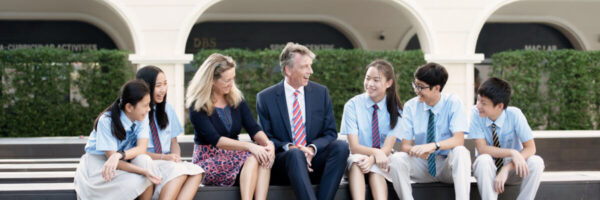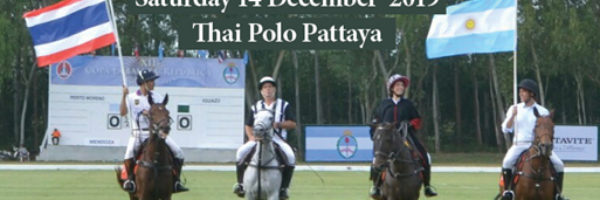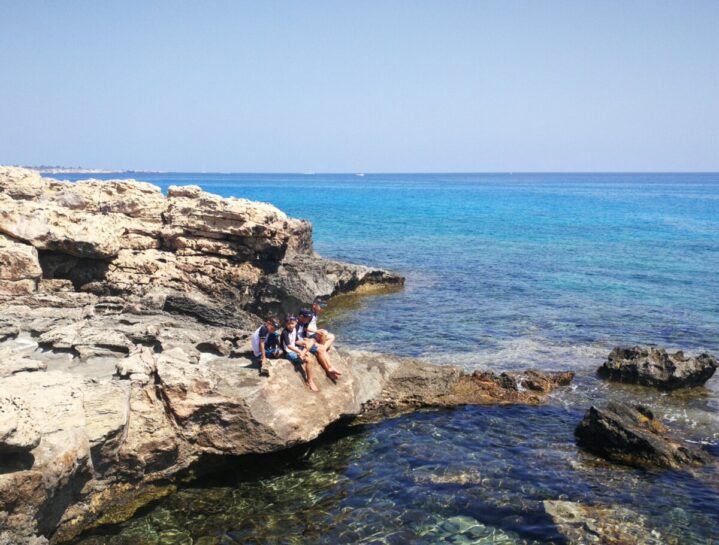
Cyprus – one island, one country or two
“Boys! Welcome to Greece!” I shouted from the front seat of our taxi. This was Tai and Logan’s 33rd country; Drake and Kiva’s 31st Nori and I had been to Greece once before; a wild two weeks in Athens, Aegina and Corfu around the 2008 Olympics. “No!” the driver groaned, as if I had garrotted him. “This is not Greece! This is Cyprus! What? I pride myself on being well-informed. I memorise obscure geographical facts (Siberian rivers, Brazilian provinces) for fun. I was certain that Cyprus was an island divided between Greece and Turkey, like Haiti and the Dominican Republic, or East Timor and Indonesia. I was, of course, completely wrong. Abashed by my ignorance, I fired up Google as soon as we were in our airbnb. I was amazed to learn that Cyprus had been independent (from the UK!) since 1960. In July 1974, Turkey sent in troops to northern Cyprus, ostensibly to protect ethnic Turks from hopped-up ethnic Greek nationalists following a Greece-supported coup d’etat. The Turkish army never left. Then in May 2004, the whole of the island joined the European Union, together with Hungary, Finland and six others. This means that Cyprus was (and is) the only EU country subject to an invasion.
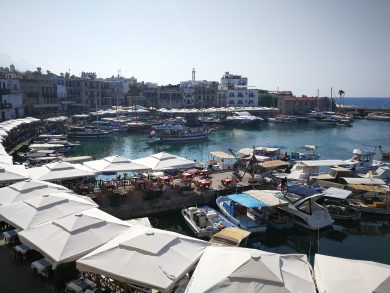 This half of the island certainly felt Greek. The language, the food, the landscape and even the light was unmistakably Greek. Despite wearing sunglasses, I got headaches from squinting so much. During the sweaty hour-long drive from Larnaca to Paralimni, I found myself muttering landscape adjectives: scorched, sun-baked, sun-bleached, parched, desiccated, pulverised, shattered. It was 100℉ outside. The A/C
This half of the island certainly felt Greek. The language, the food, the landscape and even the light was unmistakably Greek. Despite wearing sunglasses, I got headaches from squinting so much. During the sweaty hour-long drive from Larnaca to Paralimni, I found myself muttering landscape adjectives: scorched, sun-baked, sun-bleached, parched, desiccated, pulverised, shattered. It was 100℉ outside. The A/C
in our rental car was literally blowing hot air. “I could never live here,” I remarked to Nori, “I feel like I’m being X-rayed. This is what those Nazis felt like when they opened the Ark of the Covenant in the first Indiana Jones.” But Nori didn’t mind the searing heat. She was born in Bangkok, grew up in the humid suburbs of Washington D.C. and despised winter. On our travels, one of us was always unhappy temperature-wise; in Cyprus that would clearly be me. Now that we knew what Cyprus was and wasn’t, we felt compelled to visit northern Cyprus. Ahem, the Turkish Republic of Northern Cyprus, an independent nation recognised only by – wait for it – Turkey! We drove west back towards Larnaca before turning north to Nicosia/Lefkosa, “The world’s only divided capital city” – a bizarre tourism slogan.
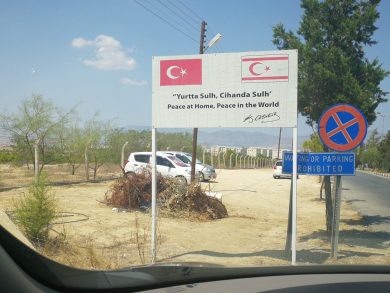 We drove around Nicosia for thirty minutes, searching for the border. I thought it would be elementary: drive north until you hit a wall, a fence, a trench or until someone with a gun waves you back. Strangely, that didn’t work at all. The roads kept looping us back south. Finally, Nori spotted a sign for Kyrenia, the Greek name for Girne, the most famous seaside resort in northern Cyprus. Crossing into northern Cyprus was no big deal – by design. Our passports didn’t get stamped (drat!) because we weren’t technically leaving Cyprus. Similarly, there was no Turkish Republic of Northern Cyprus border post for us to ‘check-in’ on the other side. We were required to buy a special insurance policy for our rental car – €25 for three days of coverage, what a racket! – but other than that, everything was easy. Upon leaving the not-really-a-border post, I realised why we’d struggled to find the frontier. Southern and Northern Cyprus were separated by a geographically absurd ‘no man’s land’ that ran in a drunken diagonal from the island’s Northwest to Southeast and ranged in width from over 4 miles to just 20 metres! Known locally as “The Green Line,” this demilitarised zone has been patrolled by UN Peacekeepers for decades.
We drove around Nicosia for thirty minutes, searching for the border. I thought it would be elementary: drive north until you hit a wall, a fence, a trench or until someone with a gun waves you back. Strangely, that didn’t work at all. The roads kept looping us back south. Finally, Nori spotted a sign for Kyrenia, the Greek name for Girne, the most famous seaside resort in northern Cyprus. Crossing into northern Cyprus was no big deal – by design. Our passports didn’t get stamped (drat!) because we weren’t technically leaving Cyprus. Similarly, there was no Turkish Republic of Northern Cyprus border post for us to ‘check-in’ on the other side. We were required to buy a special insurance policy for our rental car – €25 for three days of coverage, what a racket! – but other than that, everything was easy. Upon leaving the not-really-a-border post, I realised why we’d struggled to find the frontier. Southern and Northern Cyprus were separated by a geographically absurd ‘no man’s land’ that ran in a drunken diagonal from the island’s Northwest to Southeast and ranged in width from over 4 miles to just 20 metres! Known locally as “The Green Line,” this demilitarised zone has been patrolled by UN Peacekeepers for decades.
 The drive from the sort-of-border to Girne took less than an hour. Just before reaching the Mediterranean, the highway climbed up through a pass in the Kyrenia Mountains, which run for 160km along Cyprus’ northern coast. Though the highest point of the range (Mount Kyparissovouno) is only 1,024 metres, the rugged, limestone peaks are nonetheless dramatic because they rise directly from the sea. I turned left off the highway, following signs for Hilarion Castle. The dirt and gravel road ascended past a large Turkish army base. I smiled to see Ataturk again – it had been a long time. Even in ruins, Saint Hilarion Castle left me awestruck. Coiling atop a molar-shaped prominence with commanding views of the coast and Girne, the crenellated walls and towers evoked the fortresses of the fantasy novels I loved as a young boy. I would not have been surprised if a dragon had risen out of the hidden forest at the castle’s acme, the whump-whump of his powerful wingbeats audible miles away. Only later did I learn that the castle wasn’t a castle at all, but rather a preposterously well-defended monastery. Sorry dragon.
The drive from the sort-of-border to Girne took less than an hour. Just before reaching the Mediterranean, the highway climbed up through a pass in the Kyrenia Mountains, which run for 160km along Cyprus’ northern coast. Though the highest point of the range (Mount Kyparissovouno) is only 1,024 metres, the rugged, limestone peaks are nonetheless dramatic because they rise directly from the sea. I turned left off the highway, following signs for Hilarion Castle. The dirt and gravel road ascended past a large Turkish army base. I smiled to see Ataturk again – it had been a long time. Even in ruins, Saint Hilarion Castle left me awestruck. Coiling atop a molar-shaped prominence with commanding views of the coast and Girne, the crenellated walls and towers evoked the fortresses of the fantasy novels I loved as a young boy. I would not have been surprised if a dragon had risen out of the hidden forest at the castle’s acme, the whump-whump of his powerful wingbeats audible miles away. Only later did I learn that the castle wasn’t a castle at all, but rather a preposterously well-defended monastery. Sorry dragon.
By this stage in the journey, we had visited a lot of castles and fortresses (Philippines, Italy, San Marino, Georgia, Lebanon, England and Scotland) so we didn’t bother with a tour of Saint Hilarion. In fact, the boys only left the car briefly for a perfunctory glance at the castle and a courtesy “wow.” Kyrenia Castle (Girne Kalesi) protected the entrance to the harbour, its yellow limestone bulk providing hundreds of places where my kids might plunge to their death. And they duly scampered on and around every one of them. It was beastly hot, so we retired to a little restaurant promising ‘homemade lemonade’ and giggled as the Bangladeshi staff made no attempt to hide the gallon jug of lemon cordial.
At least we had a nice view. Girne’s compact, picturesque harbour was crowded with fishing boats and gulets, the traditional wooden Turkish sailboats that now mostly take tourists on island cruises. Restaurants and souvenir shops ringed the promenade, but there didn’t seem to be a lot of visitors. To get back at them for false advertising, all four of the boys had a poo in their bathroom.
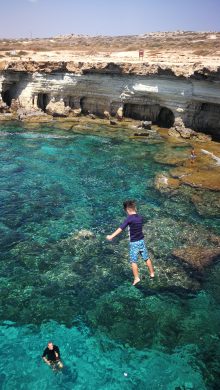 It was our beach day. Considering the number of bathers we’d seen at Sirena Bay the previous afternoon, I was skeptical that the famous Protaras and Fig Tree Bay beaches would be our scene. Instead, we drove to Cape Greco, a protected area of forest and coastline at the Southeast tip of the island. A clutch of cars and ATVs were parked where the road ended. Everybody followed the same short trail to the edge of the same low cliff, took the same photo of the bay, and returned to their vehicles. Amateurs! We walked back up the road a few hundred metres, until I spied a safe route down to the water’s edge. It took a bit of work, but we soon had an amazing beach – ok, a shelf of rock – to ourselves! Forty minutes later, the Black Pearl, a fake pirate ship, sailed into the bay. It was followed by the Aphrodite II, a mammoth yacht. “Welcome to the Blue Lagoon!” the cruise leader yelled over the boat’s public address system. Pods of life-vested tourists plopped into the water. Two jet skis roared in. Peace, serenity, shattered. I had read that Cape Greco had excellent cliff-jumping, but I didn’t know the exact location. So I systematically drove down each road. But most stopped well before the cliffs, and I wasn’t about to hike down each trail in that heat. My last chance was a rutted, dirt road that passed through a melon farm. We were surprised to see a busy car park at the bottom.
It was our beach day. Considering the number of bathers we’d seen at Sirena Bay the previous afternoon, I was skeptical that the famous Protaras and Fig Tree Bay beaches would be our scene. Instead, we drove to Cape Greco, a protected area of forest and coastline at the Southeast tip of the island. A clutch of cars and ATVs were parked where the road ended. Everybody followed the same short trail to the edge of the same low cliff, took the same photo of the bay, and returned to their vehicles. Amateurs! We walked back up the road a few hundred metres, until I spied a safe route down to the water’s edge. It took a bit of work, but we soon had an amazing beach – ok, a shelf of rock – to ourselves! Forty minutes later, the Black Pearl, a fake pirate ship, sailed into the bay. It was followed by the Aphrodite II, a mammoth yacht. “Welcome to the Blue Lagoon!” the cruise leader yelled over the boat’s public address system. Pods of life-vested tourists plopped into the water. Two jet skis roared in. Peace, serenity, shattered. I had read that Cape Greco had excellent cliff-jumping, but I didn’t know the exact location. So I systematically drove down each road. But most stopped well before the cliffs, and I wasn’t about to hike down each trail in that heat. My last chance was a rutted, dirt road that passed through a melon farm. We were surprised to see a busy car park at the bottom.
It was the viewpoint for the sea caves, dozens of caverns bored into the sheer, white cliffs of a semicircular bay. There were dozens of tourists milling about. We parked and had a look. It was truly beautiful, but nobody was doing any jumping. When I got to the edge, I saw what looked like a very promising spot. The cliff was high, but actually a bit lower than the one I’d recently leapt off in Beirut. The landing area was a wide, sandy circle surrounded by coral heads. It looked deep enough to me. But the water was so clear that I couldn’t be certain. “Never, ever jump before you’ve checked it out.” I repeated my father’s words to my sons. I scrambled down a path around the corner from the cove and swam to the entry spot. Then I took a deep breath and reverse flapped downward until my toes scraped the bottom. At least four metres, or two Daddies deep; more than adequate. By now a crowd of tourists had gathered. The boys were super-excited and proud. Their Dad was going to be the first to jump! Basking in my sons’ adulation, I took a deep breath, pumped my arms forward and jumped.
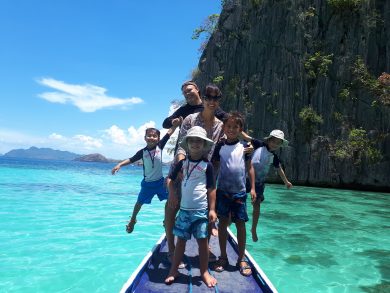 I love those weightless, silent, heart-thumping mid-air moments. People who don’t jump off cliffs into water are missing something magical. Eyes riveted on my landing spot, I adjusted my entry angle and sliced into the water. To add a bit of drama, I stayed underwater for ten seconds longer while the bubbles and splash-froth cleared. Oh My God! Did he make it? I broke the surface with a big smile on my face. People clapped and cheered. Now it was my turn to be proud of my sons and our relationship. Their trust in me was absolute. How many times had I thrown them up into the air? How many times had I caught them by their armpits as they jumped off fences, roofs, boulders or trees? Not once had I dropped them. “It’s safe!” I shouted up to the boys. “Go ahead!” It was Logan, of course, who first stepped up to the take-off point. Uncharacteristically, he hesitated. This was easily his highest cliff-jump.
I love those weightless, silent, heart-thumping mid-air moments. People who don’t jump off cliffs into water are missing something magical. Eyes riveted on my landing spot, I adjusted my entry angle and sliced into the water. To add a bit of drama, I stayed underwater for ten seconds longer while the bubbles and splash-froth cleared. Oh My God! Did he make it? I broke the surface with a big smile on my face. People clapped and cheered. Now it was my turn to be proud of my sons and our relationship. Their trust in me was absolute. How many times had I thrown them up into the air? How many times had I caught them by their armpits as they jumped off fences, roofs, boulders or trees? Not once had I dropped them. “It’s safe!” I shouted up to the boys. “Go ahead!” It was Logan, of course, who first stepped up to the take-off point. Uncharacteristically, he hesitated. This was easily his highest cliff-jump.
In a way, I was glad to see that even Mr. Fearless had his limits. But he soon found his courage and sprung off the edge. I submerged to watch him pierce the water, ready to rescue him if he landed wrong. But he was just fine. Kiva, surprisingly, came next. He spent a good thirty seconds psyching himself up before leaping.
“How old are they?” asked a Dutch man treading water beside me.
“The first one was nine and the second one was six,” I replied.
“Six years old!? Oh my God, they are so brave!”
 Drake went third and Tai, of course, went last. His father and brothers had emerged uninjured so it couldn’t be that dangerous. Since the guinea pigs (us) had survived, now dozens of tourists followed, most of them 2-5 times my boys’ ages. “Now everybody is doing it, but we were the first.” Kiva bragged, enormously self-satisfied. Enjoying the limelight, the boys jumped at least ten more times. They also encouraged the skittish to give it a try, motivating and shaming in equal measure. “If I can do it, you can do it. I’m only six years old!” When you travel with kids, Big moments are hard to predict – but you know when they happen. This was definitely one.
Drake went third and Tai, of course, went last. His father and brothers had emerged uninjured so it couldn’t be that dangerous. Since the guinea pigs (us) had survived, now dozens of tourists followed, most of them 2-5 times my boys’ ages. “Now everybody is doing it, but we were the first.” Kiva bragged, enormously self-satisfied. Enjoying the limelight, the boys jumped at least ten more times. They also encouraged the skittish to give it a try, motivating and shaming in equal measure. “If I can do it, you can do it. I’m only six years old!” When you travel with kids, Big moments are hard to predict – but you know when they happen. This was definitely one.


